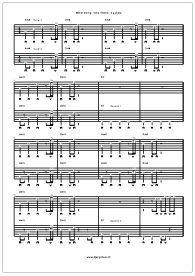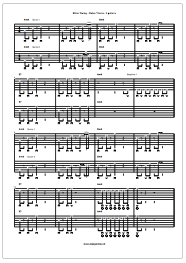
3 - Jazz Standards
The good thing about Jazz is, that there exist already hundreds of great compositions. It's fun to play them again and again.At the beginning of the 20th century, Jazz was kind of popmusic. It was played live by big-bands in dancehalls. The tunes were a mixture of chanson, popular music, songs from Broadway shows and musicals and melodies from Hollywood movies.
After time, some of these catchy and favoured songs established as standards.
In Gypsy Swing, there are many other songs and standards, like compositions from Django Reinhardt, Gypsy Bossas and waltzes.
The musical workflow of a Jazz standard
Over the decades, musicians formed a structure, that makes it easy to play together over Jazz standards.The benefit of a certain pattern is, that musicians can play together, without knowing each other and without having any rehearsal before. Just calling out the name of a song is enough and everybody knows, what he has to play.
1. A good way to start a standard is with an intro. It indicates the tempo of the song.
2. Then, the theme will be played. It is the main melody, the face of the song.
The theme will be played one chorus. That means, one cycle over all the chords of the song.
3. Then, each musician plays a solo, an improvisation over one or more choruses.
4. After the solos, the theme will be played once more, to indicate the end of the tune.
5. Sometimes, an outro will be added at the end of the theme.
2. Then, the theme will be played. It is the main melody, the face of the song.
The theme will be played one chorus. That means, one cycle over all the chords of the song.
3. Then, each musician plays a solo, an improvisation over one or more choruses.
4. After the solos, the theme will be played once more, to indicate the end of the tune.
5. Sometimes, an outro will be added at the end of the theme.
Popular Gypsy Swing Standards
If you want to play with other Gypsy Swing musicians, you should know at least about 20 Jazz standards. Learn to play the rhythm by heart.Subsequent a list with (probably) the most played Gypsy Jazz standards. Many of them are quite easy to learn.
Gypsy Swing Standards
- Minor Swing (Am)- Dark Eyes (Dm)
- Minor Blues (Gm)
- Douce Ambiance (Gm)
- Oh, Lady be good! (G)
- Autumn Leaves (Em or Gm)
- Djangology (G)
- All of me (C)
- Daphne (D)
- Coquette (D)
- I can't give you anything but love (G)
- Out of nowhere (G)
- Hungaria (G)
- Swing Gitan (Gm)
- Joseph, Joseph (Am, Bm)
- Lulu Swing (D)
- Belleville (D)
- Bossa Dorado (Dm)
- Sweet Georgia Brown (G)
- Nuages (G or F)
- Blues Clair (C)
- Clair de Lune (Dm)
- Them there eyes (D)
The goals of a musician
A good Jazz musician should know …
… the chronological sequence of the chords of each song by heart.
…how to play the chord progression of a song transposed to all 12 tonalities.
… to play the theme by heart. Professionals should be able to play it in all 12 tonalities.
… the harmony progression and the tonality changes in each song. He should know what to play over the course of the harmony.
… the chronological sequence of the chords of each song by heart.
…how to play the chord progression of a song transposed to all 12 tonalities.
… to play the theme by heart. Professionals should be able to play it in all 12 tonalities.
… the harmony progression and the tonality changes in each song. He should know what to play over the course of the harmony.
The theme
As soon as you can play the rhythm of a song by heart, study his theme as well.Each song has his peculiarity in harmony and mood. The theme will help you to find a enter point to play your imrovisation over the tune.
There are many Fakebooks (also called Realbooks) with hundreds of Jazz standards. Each song is declared on one page with the style, tempo, chords and the theme, usually written in score notation. Some songs come also with lyrics.
They are kind of cheat sheet and you can see many Jazz musicians on stage, watching their sheet while playing.
In Gypsy Swing, every note is played by heart. The reason is, that almost every Sinti cannot read score, but has a good memory.
Maybe you are lucky to find a good teacher, which explains you all the themes with intros and outros and how to play over the harmonies.
There are also many good videos on YouTube, where you can see in a close-up view how to play the theme step by step.
Djangolizer Power-User:
Each song in the Djangolizer library has a info text with suggestions of several videos on YouTube, which I think are very useful to study the song.Sounding out the theme
Instead of learning the theme by a teacher or a book, you can sound out the theme note for note by yourself.That's one of the best methods, to study music, but it takes lots of time.
Most themes are based on arpeggios or at least on scales.
Refer to the arpeggio and scale view in Djangolizer, while you study a theme.
Some of the themes are quite simple and easy to sound out.
Try tunes like "Sheik of Araby", "Oh, Lady be good" or "Limehouse Blues".
Also ballads like "Clair de Lune" or "Autumn Leaves" are suited for a try.
Listen to different versions of the same song and especially to the version of your favourite artist.
For fast and complicated themes (and solos), you can use help from software. There are Apps for Smart Phones and Tablets, slowing down the tempo of your mp3 files without changing the pitch. Nowadays, the sound quality of these algorithms is very good.
The difficulty in sounding out a melody is to find the ideal position on the fretboard and the most fluent fingering.
Very brave guitar players can try to find out, how Django played his themes and solos with just his middle- and index-finger.
The theme of "Minor Swing"
Select the song „Minor Swing“ or „Minor Swing - 5 chorus solo“ in the Djangolizer Demo version.The theme of „Minor Swing“ is played with the intervals 1, b3 and 5 over the Am and Dm chords.
I added a second guitar, which plays an alternative voice. The order of those intervals are 5, 1 and b3.
I noted two different lines over the E7 chord. Usually the bass player plays those lines.
Minor Swing - Intro theme for 2 guitars

The theme at the end of the song is played differently than the intro theme.
It is also composed in arpeggios and has a chromatic line at the end.
Minor Swing - Outro theme for 2 guitars

Djangolizer Power-User:
If you like to write down a theme or a solo note by note, you can print out the chord tabulature with additional TAB or score lines.Remember, that the most themes are played over arpeggios or scales. Set the fretboard view to arpeggio and scale, to get a hint to the right notes.
It is also easier, to remember a melody, when you know, if they belong to chord notes (arpeggio) or scale notes.



